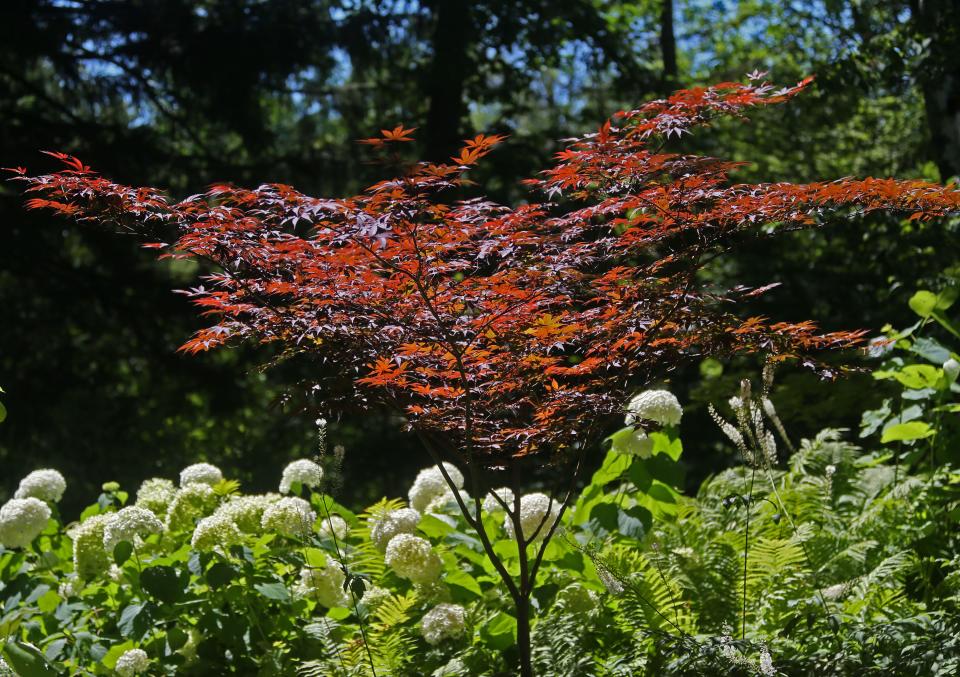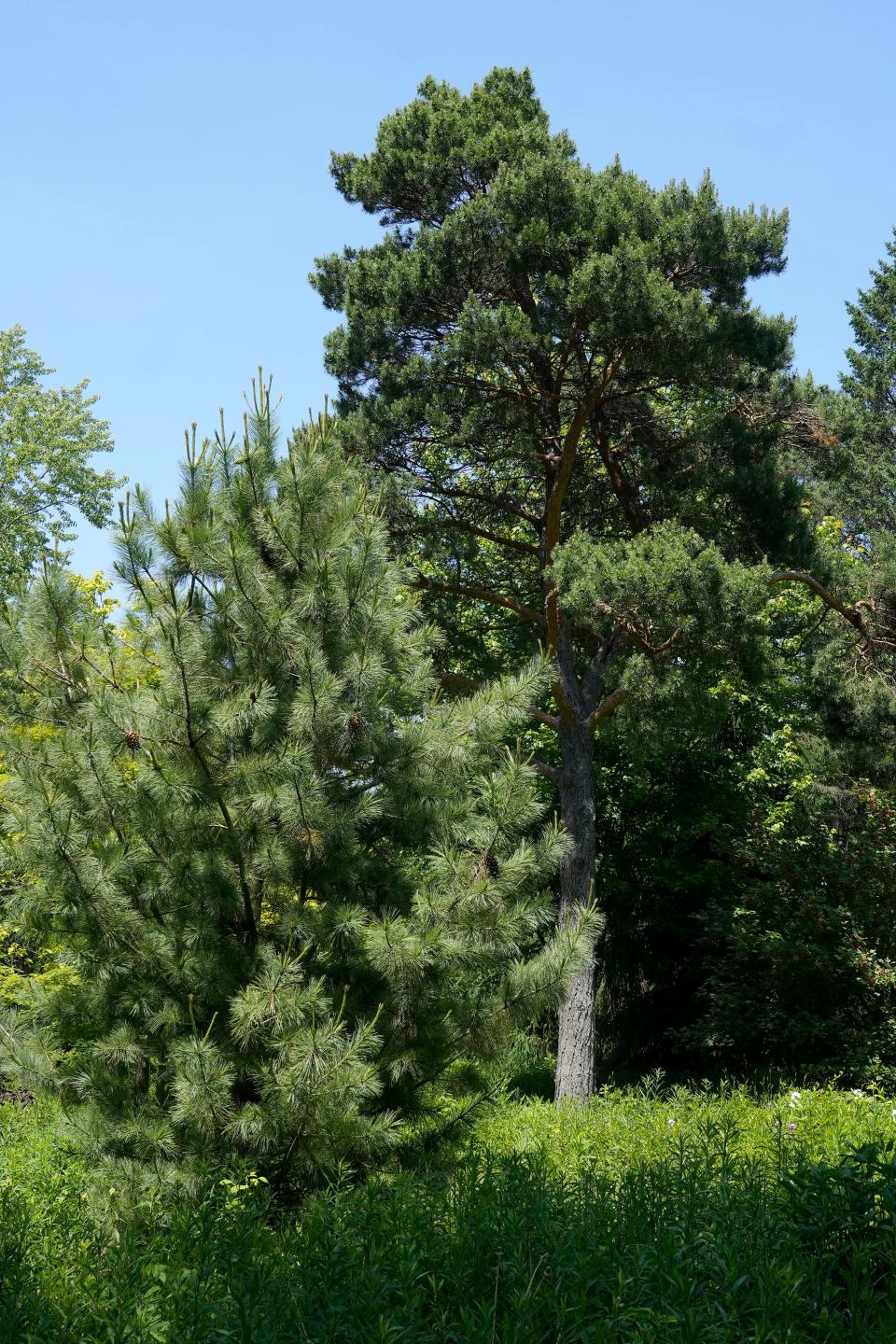Which Wisconsin trees turn what color, and when, and answers to other questions about fall colors
From climbing the Holy Hill to driving through Door County to hiking in Devil's Lake State Park, Wisconsin is full of opportunities to view vibrant autumn colors this time of year.
With hues ranging from purplish-red to bright yellow, fall leaves come in many colors. So what factors determine the colors of autumn leaves?
Here's what we found.
Why do trees lose their leaves?
Each year in the fall, non-evergreens, known as deciduous trees, drop their leaves to avoid the high energy cost of protecting them during the winter.
During the spring and summer months, leaves contain valuable nutrients extracted from the soil. Before dropping their leaves, trees suck these nutrients back into their twigs and branches to store and use again in the spring.
"Winter is hard on plants and trees, no exception," said Wisconsin Department of Natural Resources forest ecologist Brad Hutnik. "While branches, twigs and buds are equipped to handle the cold, leaves are not. They are expendable. Fallen leaves, in turn, help maintain soil structure and keep nutrients available to the whole forest community as they decompose."
More: You probably shouldn't rake up all your leaves. Here's why, according to experts.
Why do leaves change colors?
All year round, leaves' colors are determined by pigments within them. Three key pigments are present in the process of creating fall colors: chlorophyll, carotenoids and anthocyanin.
Chlorophyll gives leaves their typical green color in the spring and summer. It is also necessary for photosynthesis, the chemical reaction where plants use sunlight to create their energy, or food, source from sugar.
Carotenoids are pigments that produce yellow, orange and brown colors. They're present in corn, carrots, daffodils, buttercups, bananas and more, the U.S. Forest Service said.
Anthocyanin is a water soluble pigment that gives red, purple and blue colors to a variety of flowers, fruits and root vegetables, including cranberries, apples, blueberries and cherries.
Chlorophyll and carotenoids are present in leaf cells throughout the spring and summer "growing season." This time of year, chlorophyll is "continually being produced and broken down, and leaves appear green," the Forest Service explained.
Most of a tree's anthocyanins are produced in the autumn, in response to bright light and excess sugars within leaf cells.
As the tree prepares to drop its leaves, "the veins that carry fluids into and out of the leaf gradually close off as a layer of cells forms at the base of each leaf. These clogged veins trap sugars in the leaf and promote production of anthocyanin," the Forest Service said. Once this separation layer is complete and the connecting tissues are sealed off, the leaf is ready to fall.
As the nights get longer in the fall and trees receive less direct sunlight, chlorophyll production slows, eventually to a stop. Soon, all the chlorophyll in the leaves is destroyed, as the tree sucks the nutrients from the chlorophyll in its leaves into its branches for winter storage. With chlorophyll no longer present, the carotenoids and anthocyanin already present in the leaf are "unmasked," and their warm hues can be seen.

Why do different tree species turn different colors?
Hutnik said genetics determine what color each species will turn in the fall. For example, some species produce and present more anthocyanins than others, causing them to appear more red.
"Red maples are our best local (example) of a tree species that shows a lot of anthocyanins," Hutnik said. "The amount of anthocyanins present in leaves is determined by the genetics of each species. Aspens are a good example of a species where anthocyanins are low."
Which tree species turn what colors?
According to the Forest Service, these are the colors that leaves on popular tree species typically turn in the fall:
Oaks: red, brown or russet
Hickories: golden bronze
Aspen and yellow poplar: golden yellow
Dogwood: purplish-red
Beech: light tan
Sourwood and black tupelo: crimson
The color of maples leaves differ by species:
Red maple: brilliant scarlet
Sugar maple: orange-red
Black maple: glowing yellow
Striped maple: almost colorless
When do different tree species change color?
The timing of color changes also varies by species, the Forest Service said.
In addition to genetic variation, adverse weather effects can play a role in when trees change color. Different weather phenomena can alleviate or provide stress to trees, Hutnik said.
"Stress, like our drought-like conditions this year, may cause some trees to 'shut down' early and start fall colors early," he explained. "Too much water can have the same effect."
Additionally, "A late spring, or a severe summer drought, can delay the onset of fall color by a few weeks. A warm period during fall will also lower the intensity of autumn colors," the Forest Service said.
What to know: When Wisconsin fall colors are expected to peak in 2023
Does weather change how trees change color?
Yes, temperature and moisture influence the amount and brilliance of trees' fall colors year to year. Most of these effects take place before and during the time the chlorophyll is decreasing in the leaves.
A good string of warm, sunny days and "cool, crisp, but not freezing nights" seem to lead to the "most spectacular color displays," the Forest Service said.
Lots of sugars are produced during these warm days, and the cool nights prevent the sugars from moving out of the leaves. Lots of sugar and light mean lots of anthocyanin production, which brings brighter red colors.
Because carotenoids are always present in leaves, yellow and gold colors are most consistent from year to year.

Do all trees change colors?
No, not all trees change colors or drop their leaves. Generally, the trees that drop their leaves and change colors are called "deciduous trees" and typically have large, broad leaves.
Evergreen, or coniferous, trees generally remain green and continue the photosynthesis process through the winter. Coniferous leaves more so resemble needles. This needle shape allows them to store more water all year round, which is necessary for the photosynthesis process.
This article originally appeared on Milwaukee Journal Sentinel: Wisconsin fall colors 2023: Which trees turn first and what color?

